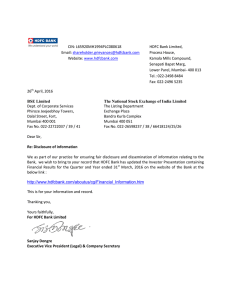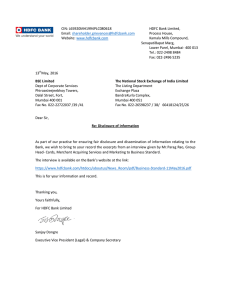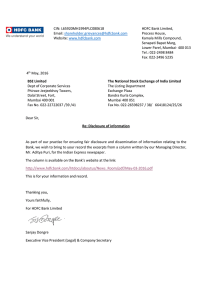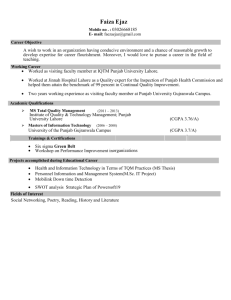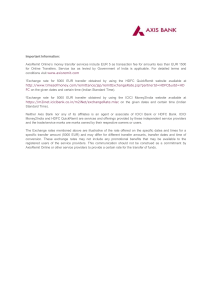International Journal of Application or Innovation in Engineering & Management... Web Site: www.ijaiem.org Email: , Volume 2, Issue 2, February 2013
advertisement
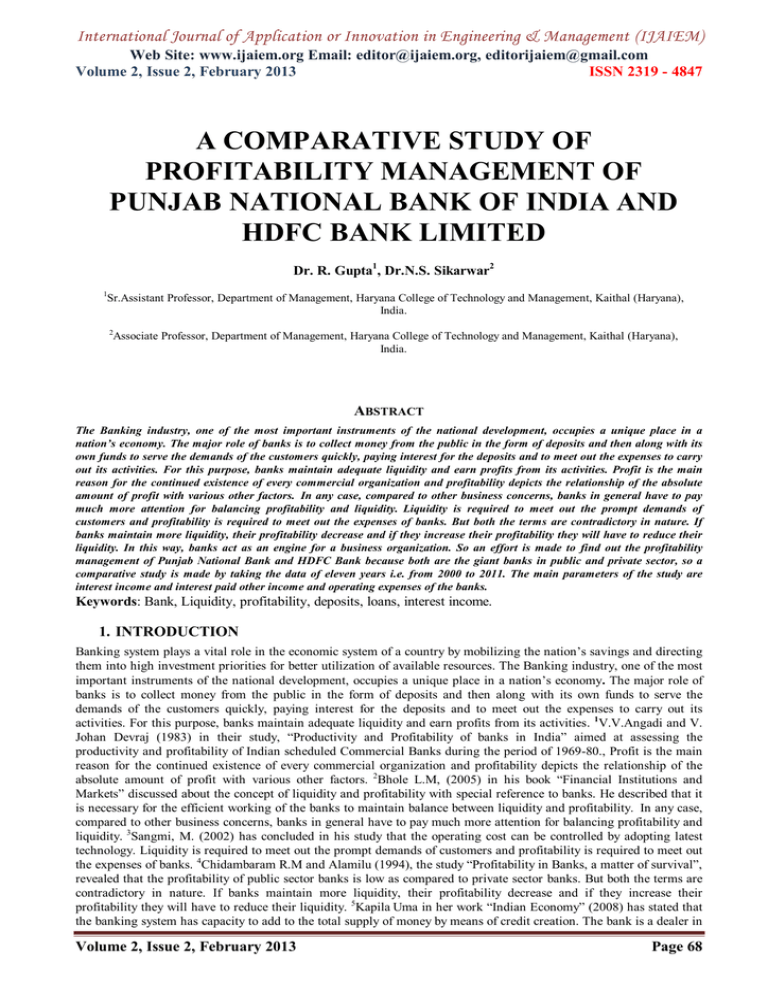
International Journal of Application or Innovation in Engineering & Management (IJAIEM) Web Site: www.ijaiem.org Email: editor@ijaiem.org, editorijaiem@gmail.com Volume 2, Issue 2, February 2013 ISSN 2319 - 4847 A COMPARATIVE STUDY OF PROFITABILITY MANAGEMENT OF PUNJAB NATIONAL BANK OF INDIA AND HDFC BANK LIMITED Dr. R. Gupta1, Dr.N.S. Sikarwar2 1 Sr.Assistant Professor, Department of Management, Haryana College of Technology and Management, Kaithal (Haryana), India. 2 Associate Professor, Department of Management, Haryana College of Technology and Management, Kaithal (Haryana), India. ABSTRACT The Banking industry, one of the most important instruments of the national development, occupies a unique place in a nation’s economy. The major role of banks is to collect money from the public in the form of deposits and then along with its own funds to serve the demands of the customers quickly, paying interest for the deposits and to meet out the expenses to carry out its activities. For this purpose, banks maintain adequate liquidity and earn profits from its activities. Profit is the main reason for the continued existence of every commercial organization and profitability depicts the relationship of the absolute amount of profit with various other factors. In any case, compared to other business concerns, banks in general have to pay much more attention for balancing profitability and liquidity. Liquidity is required to meet out the prompt demands of customers and profitability is required to meet out the expenses of banks. But both the terms are contradictory in nature. If banks maintain more liquidity, their profitability decrease and if they increase their profitability they will have to reduce their liquidity. In this way, banks act as an engine for a business organization. So an effort is made to find out the profitability management of Punjab National Bank and HDFC Bank because both are the giant banks in public and private sector, so a comparative study is made by taking the data of eleven years i.e. from 2000 to 2011. The main parameters of the study are interest income and interest paid other income and operating expenses of the banks. Keywords: Bank, Liquidity, profitability, deposits, loans, interest income. 1. INTRODUCTION Banking system plays a vital role in the economic system of a country by mobilizing the nation’s savings and directing them into high investment priorities for better utilization of available resources. The Banking industry, one of the most important instruments of the national development, occupies a unique place in a nation’s economy. The major role of banks is to collect money from the public in the form of deposits and then along with its own funds to serve the demands of the customers quickly, paying interest for the deposits and to meet out the expenses to carry out its activities. For this purpose, banks maintain adequate liquidity and earn profits from its activities. 1V.V.Angadi and V. Johan Devraj (1983) in their study, “Productivity and Profitability of banks in India” aimed at assessing the productivity and profitability of Indian scheduled Commercial Banks during the period of 1969-80., Profit is the main reason for the continued existence of every commercial organization and profitability depicts the relationship of the absolute amount of profit with various other factors. 2Bhole L.M, (2005) in his book “Financial Institutions and Markets” discussed about the concept of liquidity and profitability with special reference to banks. He described that it is necessary for the efficient working of the banks to maintain balance between liquidity and profitability. In any case, compared to other business concerns, banks in general have to pay much more attention for balancing profitability and liquidity. 3Sangmi, M. (2002) has concluded in his study that the operating cost can be controlled by adopting latest technology. Liquidity is required to meet out the prompt demands of customers and profitability is required to meet out the expenses of banks. 4Chidambaram R.M and Alamilu (1994), the study “Profitability in Banks, a matter of survival”, revealed that the profitability of public sector banks is low as compared to private sector banks. But both the terms are contradictory in nature. If banks maintain more liquidity, their profitability decrease and if they increase their profitability they will have to reduce their liquidity. 5Kapila Uma in her work “Indian Economy” (2008) has stated that the banking system has capacity to add to the total supply of money by means of credit creation. The bank is a dealer in Volume 2, Issue 2, February 2013 Page 68 International Journal of Application or Innovation in Engineering & Management (IJAIEM) Web Site: www.ijaiem.org Email: editor@ijaiem.org, editorijaiem@gmail.com Volume 2, Issue 2, February 2013 ISSN 2319 - 4847 credit-its own and other people’s. It is because of an ability to manipulate credit that banks are used extensively as a tool of monetary policy. In this way, banks act as an engine for a business organization. So an effort is made to find out the profitability management of Punjab National Bank and HDFC Bank because both are the giant banks in public and private sector, so a comparative study is made by taking the data of eleven years i.e. from 2000 to 2011. The main parameters of the study are interest income and interest paid other income and operating expenses of the banks. As regards Punjab National Bank, it was established in 1895 and it holds the distinction of being the first Indian bank to have been started exclusively with Indian capital. Bank has a strong capital base with capital adequacy ratio of 12.42%. The bank has over 60 million customers through 5286 offices including 421 extension counters. The bank has a paid up capital of ` 316.81 crore. As regards HDFC Bank, it was established by Reserve Bank of India in 1994. It was the first bank to get approval from RBI to set up in private sector. Bank has a nationwide network of 2000 Branches and 5,998 ATM's in 996 Indian towns and cities. The authorized share capital of the bank is ` 550 crore. The paid-up capital of the bank is ` 459, 69, and 07,030. 2. RESEARCH METHODOLOGY The necessary information on the subject has been collected from the diverse sources. Necessary data and information have been mainly collected from the head offices of Punjab National Bank and HDFC Bank in the form of annual reports. The data so collected has been classified and analyzed and tabulated in such a manner that by using percentage and other appropriate techniques of statistical analysis, fruitful and scientific inferences regarding profitability management in Punjab National Bank and HDFC Bank could be derived. Besides this, personal interviews and discussions with the various authorities of the banks has also been made so as to enrich the conclusions and make inferences useful to all the concerned be they, the management, the owners, the policy makers, customers or the employees. Mainly three techniques for financial analysis (i) Arithmetic technique, which consists of percentage change over a particular period, (ii) Accounting techniques, which consists of Ratio Analysis and (iii) Statistical techniques, such as Arithmetic Mean, Standard Deviation, Coefficient of Variation are used for analyses. The study covers a period of eleven years i.e. from 2000-01 to 2010-11. 2.1 OBJECTIVES OF THE STUDY The main objectives of the study are to know; (i) The Profitability Management in the units; (ii) Impact of operating expenses on the profitability of the banks. 2.2 CONCEPT OF EARNINGS Profitability alternatively known as Earnings connotes the ability of a given investment to earn a return from its use. Appraisal of profitability indicates how far the organization has got success in achieving its objective. The amount of earnings indicates the efficiency of the organization. The larger the profits, the more efficient and profitable the organization becomes. That is why profitability is considered, to a large extent, one of the main criteria to adjudge the extent to which the management has been successful in the effective utilization of the funds available with the enterprise. 2.3 SOURCES OF INCOME As Punjab National Bank and HDFC Bank both perform mainly banking activities, hence, Interest is the major source of income of these banks. The amount of interest earned by Punjab National Bank and HDFC Bank comprises mainly of Interest and Discount on Advances of Bills, Income from investment, Interest on Balance with RBI & Other InterBank Funds and Others. However, other source of income of Punjab National Bank and HDFC Bank consist of Commission, Exchange & Brokerage, Profit/(Loss) on sale of building and other assets, Profit/(loss) on Foreign Exchange Transactions, Profit/(Loss) on revaluation of investment and Miscellaneous Income. Item-wise analysis of sources of income of these two banks has been discussed here as under. 2.4 INTEREST EARNED A bank advances money to different types of customers for different periods at different rates of interest as per the rules given by R.B.I., Central Government and policy of the bank (Flexible Rate) during a period of financial year. As per Banking Act, such income is defined under schedule 13 of the final accounts of a Commercial Bank. Interest earned is divided into following heads as per schedule number 13. (i) Interest on Advances and discount on bills: - The most important income for the banks is the interest earned on all types of loans and advances like cash credit, demand, loans, overdraft, term loans etc. The customers of the bank get their bills discounted from bank and the amount of discount deducted by the bank from and income for the bank. This amount of discount is too included under this head. Volume 2, Issue 2, February 2013 Page 69 International Journal of Application or Innovation in Engineering & Management (IJAIEM) Web Site: www.ijaiem.org Email: editor@ijaiem.org, editorijaiem@gmail.com Volume 2, Issue 2, February 2013 ISSN 2319 - 4847 (ii) Income on investment: - Bank invests its money in shares, debenture bonds and other Govt. and non Govt. securities. The dividend, interest and other income on these securities from investment portfolio is the part of this sub head. (iii) Interest on balances with R.B.I. and other interbank funds: - this includes the income earned by the banks in the form of interest with the transaction with R.B.I. and inters banks. (iv) Others: - it includes any other interest or discount income not included in the above heads. As regards interest earned Punjab National Bank and HDFC Bank, it has been worked out and shown in table 1 Table 1: Interest Earned to Total Income Year Punjab National Bank HDFC Bank Interest earned Total income Interest earned Total income ` in lac ` in lac % of int. earned to total income ` in lac `in lac % of int. earned to total income 2000-01 586348 664190 88.28 125504 144499 86.85 2001-02 664787 762559 87.17 168118 203624 82.56 2002-03 748501 873532 85.68 196317 247916 79.18 2003-04 777970 976438 79.67 245571 302896 81.07 2004-05 845985 1031439 82.01 290543 374483 77.58 2005-06 958415 1106238 86.63 423018 559932 75.54 2006-07 1153748 1288112 89.56 664793 816416 81.43 2007-08 1426502 1626258 87.72 1011500 1239815 81.58 2008-09 1932616 2224585 86.87 1633226 1962286 83.23 2009-10 2146691 2503222 85.75 1617290 1998051 80.94 2010-11 2698648 3059906 88.19 1992821 2426336 82.13 (Source: Punjab National Bank and HDFC Bank; Annual Report- various issues.) Table 1 reveals that the ratio of interest earned to total income in Punjab National Bank decreased initially and later on the ratio improved and it again decreased in 2009-10 but increased in 2010-11. Whereas the ratio of interest earned to total income initially decreased then increased in case of HDFC Bank but later on increased, Coefficient of variations being .36% in case of Punjab National Bank and .35% in case of HDFC Bank is less than that of Punjab National Bank indicating less variability in case of HDFC Bank. The entire situation can be reflected at a glance with the help of the Graph –1 Graph-1: Interest Earned to Total Income Other income Incomes except interest income of bank are given in schedule 14 of the Profit and Loss account of the bank. Such income includes; Volume 2, Issue 2, February 2013 Page 70 International Journal of Application or Innovation in Engineering & Management (IJAIEM) Web Site: www.ijaiem.org Email: editor@ijaiem.org, editorijaiem@gmail.com Volume 2, Issue 2, February 2013 ISSN 2319 - 4847 (i) Commission, Exchange and Brokerage: it also includes all incomes and remuneration received by a bank on the various services rendered to its customers, clients and public. These cover such as commission on collection, commission on exchange on remittances and transfers, commission on letters of credit, letting out of lockers and guarantees. Brokerage on securities purchased on behalf of its customers etc; (ii) Profit on sale of investments less loss on sale of investment; (iii) Profit on revaluation of investment less loss on revaluation of investment; (iv) Profit on sale of land, building and other assets less loss on sale of land, building and other assets; (v) Profit on exchange transaction less loss on exchange transactions. It includes all incomes earned by way of foreign exchange, commission and charges on foreign exchange, commission and charges on foreign exchange transactions excluding interest which will be shown under interest; (vi) Income earned by way of dividends etc. from subsidiary companies and joints venture; (vii) Miscellaneous incomes As regards other income to total income ratio of Punjab National Bank and HDFC Bank, it has been worked out and shown in table 2 Table- 2: Other Income to Total Income Year Other income ` in lac Punjab National Bank Total income % of other income to total income ` in lac HDFC Bank Other income ` in lac Total income ` in lac % of other income to total income 2000-01 77842 664190 11.72 18553 144499 12.22 2001-02 97772 762559 12.82 33325 203624 16.36 2002-03 125031 873532 14.31 46555 247916 18.78 2003-04 198468 976438 20.33 48003 302896 15.85 2004-05 185454 1031439 17.98 65134 374483 17.39 2005-06 147823 1106238 13.36 112398 559932 20.07 2006-07 134364 1288112 10.43 151623 816416 18.57 2007-08 199756 1626258 12.28 228315 1239815 18.42 2008-09 291969 2224585 13.12 329060 1962286 16.77 2009-10 356531 2503222 14.24 380761 1998051 19.06 2010-11 361258 3059906 11.80 433515 2426336 17.86 (Source: Punjab National Bank and HDFC Bank; Annual Report- various issues.) Table 2 reveals that the other income of Punjab National Bank is 11.72% in 2000-01 and 11.80% in 2010-11 whereas that of other income of HDFC Bank is 12.22% in 2000-01 and 17.86% in 2010-11 which is showing an increasing trend. We can analyze that in this way Punjab National Bank is performing better because the other income is less than HDFC Bank. The entire situation can be reflected at a glance with the help of the Graph – 2 Graph-2: Other Income to Total Income Heads of Expenditure Banks accepts deposits on which they pay interest to their customers. The amount of interest expended by Punjab National Bank & HDFC Bank consists mainly of interest on Deposits and Inter Bank borrowings. However, other items of expenditure of Punjab National Bank & HDFC Bank consists of payment to and provisions for employees, Rent, Taxes Advertisement & Publicity, Depreciation on Assets other than Leased Assets, Director Fee, Allowances, Postage and Telegrams and Other Expenditure. Item- wise analysis of expenses of the two banks has been discussed as below: Interest Expanded Volume 2, Issue 2, February 2013 Page 71 International Journal of Application or Innovation in Engineering & Management (IJAIEM) Web Site: www.ijaiem.org Email: editor@ijaiem.org, editorijaiem@gmail.com Volume 2, Issue 2, February 2013 ISSN 2319 - 4847 A Bank has to pay interest on various types of deposits by the customer in different types of accounts like fixed deposits, saving account and current account and recurring account. These accounts are opened by clients for different period. The bank pays different rates of interest. The interest paid by bank is an expenditure of the bank for the accounting period. This includes; (i) Interest on deposits, it includes interest paid on all types of deposits of the customers with the bank. Interest is paid at the given rate as per the direction of R.B.I. on different types of deposits for the period of deposit with the bank by customers. These deposits may be saving account, current account, fixed account, recurring deposits etc. (ii) Interest paid by a Commercial Bank on the borrowing from RBI or from other Commercial Banks. (iii) Interest paid by bank on other borrowings like public borrowing public deposits or other deposits with the bank. As regards the interest expended of Punjab National Bank and HDFC Bank, it has been shown in Table 3 Table 3: Interest Expended to Total Expenditure Year Punjab National Bank Interest expended HDFC Bank Total Expenditure ` in lac % of int. exp. To total exp. Interest expended Total Expenditure ` in lac ` in lac % of int. exp. To total exp ` in lac 2000-01 382505 617825 61.91 75375 123487 61.04 2001-02 435258 706319 61.62 107374 173920 61.74 2002-03 436129 789312 55.25 119196 209156 56.53 2003-04 415499 853788 48.67 121105 251946 48.07 2004-05 445311 872541 51.04 131556 307927 42.72 2005-06 491738 937601 52.45 192950 472854 40.81 2006-07 602291 1103969 54.56 317945 702271 45.27 2007-08 873086 1421382 61.43 438273 1080797 40.55 2008-09 1229530 1915497 64.19 891111 1737792 51.28 2009-10 1294402 2112686 61.27 778630 1703181 45.72 2010-11 1517914 2616556 58.01 938508 2033696 46.14 (Source: Punjab National Bank and HDFC Bank; Annual Report- various issues.) Table 3 reveals that total expenditure of the both the banks include interest paid as their major portion of expenditure. The comparison of both the banks then the Punjab National Bank is spending more than HDFC Bank as interest expended. We can see that the ratio of interest expended to total expenditure is 61.91% in 2000-01 and it is almost same over the period of study but the ratio of HDFC Bank is declining. The entire situation can be reflected at a glance with the help of the Graph – 3 Operating Expenses Those expenses which are incurred by bank on its day to day working for carrying out its normal activities and functions are known as operating expenses. These are explained under schedule 16 of final account of the Banking companies act. These include; (i) Payment to and provisions for employees; (ii) Rent, taxes and lighting; (iii) Printing and stationery; (iv) Advertisement; (v) Depreciation on Banks property like furniture, building, vehicles, and others; (vi) Directors fees and allowances ; (vii) Auditors fees; (viii) Law charges; (ix) Postage, telegrams, telephone, mobile expanses; (x) Repairs and maintenance; (xi) Insurance; and (xii) Other expenses- like traveling, entertainment, Volume 2, Issue 2, February 2013 Page 72 International Journal of Application or Innovation in Engineering & Management (IJAIEM) Web Site: www.ijaiem.org Email: editor@ijaiem.org, editorijaiem@gmail.com Volume 2, Issue 2, February 2013 ISSN 2319 - 4847 newspaper, magazines, donators, license fees etc. As regards Operating Expenses of Punjab National Bank and HDFC Bank it has been shown in Table 4 Graph – 3: Interest Expended Table 4 Operating Expenses Year Operating expenses Punjab National Bank HDFC Bank Total expenditure Operating expenses ` in lac % of oper. Exp. To total exp. ` in lac Total expenditure ` in lac % of oper. Exp. To total exp. ` in lac 2000-01 187164 617825 30.29 30959 123487 25.07 2001-02 179920 706319 25.47 41795 173920 24.03 2002-03 205673 789312 26.06 57705 210847 27.37 2003-04 237072 853788 27.77 81000 251946 32.15 2004-05 297521 872541 34.10 108540 307927 35.25 2005-06 302315 937601 32.24 169109 472854 35.76 2006-07 332623 1103969 30.13 242080 702271 34.47 2007-08 352548 1421382 24.80 374562 1080797 34.66 2008-09 420620 1915497 21.96 553281 1737792 31.84 2009-10 476192 2112686 22.54 576448 1703181 33.85 2010-11 636422 2616556 24.32 715291 2033696 35.17 (Source: Punjab National Bank and HDFC Bank; Annual Report- various issues.) Table 4 analyses that operating expenditure of Punjab National Bank is 30.29% in 2000-01 and it came down to 24.32% in 2010-11 and that of HDFC Bank was 25.07% in 2000-01 and increased to 35.17% in 2010-11. So in total expenditure, Punjab National Bank is spending less on operating expenses whereas HDFC Bank is spending more on operating expenses. The entire situation can be reflected at a glance with the help of the Graph – 4 Graph – 4: Operating Expenses to Total Expenditure Net Profit Ratio Every business entity wants to know the net result of its activities carried out during the financial year. This is known by preparing final accounts i.e. trading account, profit and loss account, profit and loss appropriation account or revenue account. Net profit is the profit after paying all expenses, interest, reserves and taxes provisions from business Volume 2, Issue 2, February 2013 Page 73 International Journal of Application or Innovation in Engineering & Management (IJAIEM) Web Site: www.ijaiem.org Email: editor@ijaiem.org, editorijaiem@gmail.com Volume 2, Issue 2, February 2013 ISSN 2319 - 4847 activities as well as non business activities. The increase in profits over the period strengthen and consolidate the business and helps to increase the moral and good will of the business as well as of all inside and outside parties concerned with the business like management employees, shareholders, creditors. Govt. tax deptt, general public, researchers and future investors in the business. Increase in profits over a period increases the goodwill and faith in business activities and it encourages the new entrepreneur to enter into these activities with new technology and new bold which has its positive impact on the economy of the country and increases the level of standard of living of general public ultimately boosting in the investment activities. The recent example is public issue of coal India ltd. Net Profit Ratio in respect of Punjab National Bank and HDFC Bank it has been worked out by taking Net Profits as numerator and total business which means Deposits, Borrowings, Advances and Trading Investment as denominator. Net profits here means net profit after taxes and shown here under; Net Profit Ratio = Net Profits 100 Total Business As regards Net Profit Ratio of Punjab National Bank and HDFC Bank it has been calculated as shown in Table 5 Table 5 Net Profit Ratio Year Punjab National Bank Net Profit Total Business ` in lac ` in lac Net profit ratio In % HDFC Bank Net Profit ` in lac Total Business ` in lac Net profit ratio In % 2000-01 46364 8417429 0.55 21012 1629477 1.29 2001-02 56239 9849289 0.57 29704 2446753 1.21 2002-03 84220 11604161 0.73 38760 3413093 1.14 2003-04 110869 13514111 0.82 50950 4815337 1.06 2004-05 141012 16357963 0.86 66556 6192055 1.07 2005-06 143931 19431228 0.74 87078 9085808 0.96 2006-07 154008 23645619 0.65 114145 11524272 0.99 2007-08 204876 28595879 0.72 159018 16419550 0.97 2008-09 309088 36446347 0.85 224494 24169463 0.93 2009-10 390536 45908029 0.85 294870 29323503 1.01 2010-11 443349 36856907 1.20 392640 36856906 1.06 (Source: Punjab National Bank and HDFC Bank; Annual Report- various issues.) Table 5 reveals that the amount of Net Profit Margin of Punjab National Bank increased from 0.55 percent in 2000-01 to 1.20 percent in 2010-11, indicating an increase of 0.65 percent whereas that of HDFC Bank decreased from 1.29 percent in 2000-01 to 1.06 percent in 2010-11 indicating a decrease of 0.28 percent over the period under study. In order to study the average behaviors, Mean has been calculated and in order to study the variability between the two series Coefficient of Variation of Net Profit Ratio has been calculated in respect of Punjab National Bank & HDFC Bank as shown in Table 6The entire situation can be reflected at a glance with the help of the Graph -5 Graph – 5: Net Profits Ratio Volume 2, Issue 2, February 2013 Page 74 International Journal of Application or Innovation in Engineering & Management (IJAIEM) Web Site: www.ijaiem.org Email: editor@ijaiem.org, editorijaiem@gmail.com Volume 2, Issue 2, February 2013 ISSN 2319 - 4847 Table 6: Mean, Standard Deviation, Coefficient of Variation of Net Profit Ratio Punjab National Bank Year Net Profit Ratio ( X1 ) 2000-01 2001-02 2002-03 2003-04 2004-05 2005-06 2006-07 2007-08 2008-09 2009-10 2010-11 0.55 0.57 0.73 0.82 0.86 0.74 0.65 0.72 0.85 0.85 1.20 X 1 8 . 54 HDFC Bank (X1 X 1) ( X1 X 1 )2 Net Profit Ratio -0.184 -0.164 -0.004 0.086 0.126 0.006 -0.084 -0.014 0.116 0.116 0.424 0 0.0339 0.0269 0.0000 0.0074 0.0159 0.0000 0.0071 0.0002 0.0135 0.0135 0.1790 (X 1.29 1.21 1.14 1.06 1.07 0.96 0.99 0.97 0.93 1.01 1.06 = 1 X (X2) 1 ) 2 X 2 11.69 (X 2 X 2 ) (X 2 X 2 )2 0.227 0.147 0.077 -0.003 0.007 -0.103 -0.073 -0.093 -0.133 -0.053 -0.003 0 0.0515 0.0216 0.0059 0.0000 0.0000 0.0106 0.0053 0.0086 0.0177 0.0028 0.0000 ( X 2 X 2 )2 = X 1 0.776 X1 0.1643 C.V. of X1 21.17 X 2 1.063 X 2 0.1062 C.V. of X 2 9.99 Table 6 reveals that Net Profit Ratio of Punjab National Bank accounted for 0.776 percent whereas that HDFC Bank stood to be 1.063 percent on an average over the corresponding period. It indicates that HDFC Bank got better success in maximizing its Net Profit as compared to Punjab National Bank. Coefficient of variation being 9.99 percent in case of HDFC Bank is less than that of Punjab National Bank being 21.17 percent indicating more consistency in case of HDFC Bank. 3. ANALYSIS AND FINDINGS (i) Total income of Punjab National Bank increased from ` 664190 lac in 2001-02 to ` 3059906 lac in 2010-11 indicating an increase of 4.60 times whereas that of HDFC Bank increased from ` 144999 lac in 2000-01 to 2426336 ` lac in 2010-11 indicating an increase of 16.73 times over the corresponding period. (ii) Total expenditure of Punjab National Bank increased from `617825 lac in 2001-02 to ` 2616556 lac in 201011 indicating an increase of 4.23 times whereas that of HDFC Bank increased from `123487 lac in 2000-01 to ` 2033696 lac in 2010-11 indicating an increase of 16.46 times over the corresponding period. (iii) Punjab National Bank got better success in maximizing its Operating Profit as compared to HDFC Bank. Coefficient of variation being 9.99 percent in case of HDFC Bank is less than that of Punjab National Bank being 21.17 percent indicating less variability in case of HDFC Bank. (iv) Net Profit after tax of Punjab National Bank increased from `46364 lac in 2001-02 to ` 443349 lac in 2010-11 indicating an increase of 9.56 times whereas that of HDFC Bank increased from ` 21012 lacs in 2000-01 to ` 392640 lac in 2010-11 indicating an increase of 18.68 times over the corresponding period. (v) Net Profit Ratio of Punjab National Bank accounted for 0.776 percent whereas that HDFC Bank stood to be 1.063 percent on an average over the corresponding period. It indicates that HDFC Bank got better success in maximizing its Net Profit as compared to Punjab National Bank. Coefficient of variation being 9.99 percent in case of HDFC Bank is less than that of Punjab National Bank being 21.17 percent indicating more consistency in case of HDFC Bank. 4. CONCLUSION On the basis of study of profitability management, based on the parameters like Total Income, Total Expenditure, Net Profits and Operating Expenses, it can be concluded very safely that the study of last eleven years i.e. from 2000 to 2011 HDFC Bank has performed much better than Punjab National Bank and all the banks must refer the suggestions provided in the study in order to improve their efficiency. REFERENCES [1] [2] [3] [4] Bhole, L. M., “Financial Institution & Markets”, Tata Mcgraw Hill Publications Ltd., New Delhi, 2000. Bidani, S.N., “Managing Non Performing Assets in Banks”, Vision Books Pvt. Ltd., New Delhi, 2003. Dutt, Ruddar and Sundaram, K. P. M., “Indian Economy”, S. Chand & Company Pvt. Ltd., New Delhi, 2003. Gupta, S.P., Statistical Methods (2000), S. Chand and Sons,New Delhi. Volume 2, Issue 2, February 2013 Page 75 International Journal of Application or Innovation in Engineering & Management (IJAIEM) Web Site: www.ijaiem.org Email: editor@ijaiem.org, editorijaiem@gmail.com Volume 2, Issue 2, February 2013 ISSN 2319 - 4847 [5] Gupta, Shashi K., Aggarwal, Nisha and Gupta, Neeti, “Financial Institutions and Markets”, Kalyani Publishers, New Delhi, 2004. [6] Jain, T. R., Khanna, O. P., “Indian Financial System”, V. K. Publications, New Delhi, 2007. [7] Kapila Uma “Indian Economy, performance and policies “Academic Foundation New Delhi ed. Eighth, 2008-09. [8] Khan, M. Y., Indian Financial System, Tata McGraw-Hill Publishing Company Ltd., New Delhi, 1996. [9] Kothari, C.R., Social Banking and Profitability, ArihantPublishers, Jaipur, 1991. [10] Advanced Auditing and Professional Ethics Vol.I Final New Course Board of Studies The Institute of Chartered Accountants of India page 11.1 [11] CA (Course-I), Economics Board of Studies, the Institute of Chartered Accountants of India, (Economics), p 301 [12] The Financial Express, “RBI Liberalizes NPA Norms”, July, 2011. [13] Report on Trend and Progress of Banking in India. [14] RBI Bulletin, August, 20011 Master Circular DBOD No. P.BC.1/21.04.048/2005-06, April, 2006. [15] Punjab National Bank; Annual Report; various issues. [16] HDFC Bank; Annual Report; various issues. Volume 2, Issue 2, February 2013 Page 76
